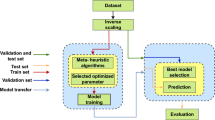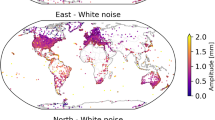Abstract
Ground motion prediction equations (GMPEs) are developed using past strong-motion records to predict the effect of future events. Often, the records in the database are incomplete, not covering all possible input scenarios or not recorded at the site of interest for performing site-specific hazards. Such cases are handled by adjusting the GMPEs to suit the required site/region characteristics. Recent studies have shown that scaling the Fourier amplitude spectrum (FAS) rather than the pseudo-spectral acceleration (PSA) is physically justifiable. The present work develops a recurrent neural network to predict the PSA ordinates from the FAS and duration (D5-95) for the New Zealand region. The developed network has no potential underfit or overfit and has a strong correlation coefficient, R > 0.97, with total sigma values in the range of 0.1–0.13 (log10 units). If the predicted FAS and duration are used as inputs, its uncertainty must be included in the final sigma, which lies from 0.25 to 0.3 (log10 units). At low frequency, scaling of FAS and PSA values is identical. In contrast, scaling of higher-frequency FAS values affects the wide range of the PSA values, with a prominent effect initially observed at lower frequencies and later at higher frequencies.
















Similar content being viewed by others
References
Ahumada, A., Altunkaynak, A., & Ayoub, A. (2015). Fuzzy logic-based attenuation relationships of strong motion earthquake records. Expert Systems with Applications, 42(3), 1287–1297. https://doi.org/10.1016/j.eswa.2014.09.035
Akkar, S., Sandıkkaya, M. A., Şenyurt, M., Sisi, A. A., Ay, B. Ö., Traversa, P., Douglas, J., Cotton, F., Luzi, L., Hernandez, B., & Godey, S. (2014). Reference database for seismic ground-motion in Europe (RESORCE). Bulletin of Earthquake Engineering, 12(1), 311–339. https://doi.org/10.1007/s10518-013-9506-8
Al Atik, L., Abrahamson, N., Bommer, J. J., Scherbaum, F., Cotton, F., & Kuehn, N. (2010). The variability of ground-motion prediction models and its components. Seismological Research Letters, 81(5), 794–801. https://doi.org/10.1785/gssrl.81.5.794
Ancheta, T. D., Darragh, R. B., Stewart, J. P., Seyhan, E., Silva, W. J., Chiou, B.S.-J., Wooddell, K. E., Graves, R. W., Kottke, A. R., Boore, D. M., Kishida, T., & Donahue, J. L. (2014). NGA-West2 database. Earthquake Spectra, 30(3), 989–1005. https://doi.org/10.1193/070913EQS197M
Atkinson, G. M. (2008). Ground-motion prediction equations for eastern North America from a referenced empirical approach: Implications for epistemic uncertainty. Bulletin of the Seismological Society of America, 98(3), 1304–1318. https://doi.org/10.1785/0120070199
Boore, D. M. (2003). Simulation of ground motion using the stochastic method. Pure and Applied Geophysics, 160(3), 635–676. https://doi.org/10.1007/PL00012553
Bora, S. S., Cotton, F., & Scherbaum, F. (2019). NGA-West2 empirical Fourier and duration models to generate adjustable response spectra. Earthquake Spectra, 35(1), 61–93. https://doi.org/10.1193/110317EQS228M
Bora, S. S., Scherbaum, F., Kuehn, N., & Stafford, P. (2014). Fourier spectral-and duration models for the generation of response spectra adjustable to different source-, propagation-, and site conditions. Bulletin of Earthquake Engineering, 12(1), 467–493. https://doi.org/10.1007/s10518-013-9482-z
Bora, S. S., Scherbaum, F., Kuehn, N., & Stafford, P. (2016). On the relationship between Fourier and response spectra: Implications for the adjustment of empirical ground-motion prediction equations (GMPEs). Bulletin of the Seismological Society of America, 106(3), 1235–1253. https://doi.org/10.1785/0120150129
Bora, S. S., Scherbaum, F., Kuehn, N., Stafford, P., & Edwards, B. (2015). Development of a response spectral ground-motion prediction equation (GMPE) for seismic-hazard analysis from empirical Fourier spectral and duration models. Bulletin of the Seismological Society of America, 105(4), 2192–2218. https://doi.org/10.1785/0120140297
Bradley, B. A. (2013). A New Zealand-specific pseudospectral acceleration ground-motion prediction equation for active shallow crustal earthquakes based on foreign models. Bulletin of the Seismological Society of America, 103(3), 1801–1822.
Campbell, K. W. (2003). Prediction of strong ground motion using the hybrid empirical method and its use in the development of ground-motion (attenuation) relations in eastern North America. Bulletin of the Seismological Society of America, 93(3), 1012–1033. https://doi.org/10.1785/0120020002
Derras, B., Bard, P. Y., & Cotton, F. (2016). Site-condition proxies, ground motion variability, and data-driven GMPEs: Insights from the NGA-West2 and RESORCE data sets. Earthquake Spectra, 32(4), 2027–2056. https://doi.org/10.1193/060215EQS082M
Dhanya, J., & Raghukanth, S. T. G. (2020). Neural network-based hybrid ground motion prediction equations for Western Himalayas and North-Eastern India. Acta Geophysica, 68(2), 303–324. https://doi.org/10.1007/s11600-019-00395-y
Fayaz, J., Xiang, Y., & Zareian, F. (2021). Generalized ground motion prediction model using hybrid recurrent neural network. Earthquake Engineering and Structural Dynamics, 50(6), 1539–1561. https://doi.org/10.1002/eqe.3410
Frazier, P. I. (2018). Bayesian optimization. In Recent advances in optimization and modeling of contemporary problems, Informs (pp. 255–278). https://doi.org/10.1287/educ.2018.0188
Golbraikh, A., & Tropsha, A. (2002). Beware of q2! Journal of Molecular Graphics and Modelling, 20(4), 269–276. https://doi.org/10.1016/s1093-3263(01)00123-1
Hochreiter, S. (1998). The vanishing gradient problem during learning recurrent neural nets and problem solutions. International Journal of Uncertainty, Fuzziness and Knowledge-Based Systems, 6(02), 107–116.
Hochreiter, S., & Schmidhuber, J. (1997). Long short-term memory. Neural Computation, 9(8), 1735–1780.
Hudson, D. E. (1962). Some problems in the application of spectrum techniques to strong-motion earthquake analysis. Bulletin of the Seismological Society of America, 52(2), 417–430.
Kaiser, A., Van Houtte, C., Perrin, N., Wotherspoon, L., & McVerry, G. (2017). Site characterisation of GeoNet stations for the New Zealand strong motion database. Bulletin of the New Zealand Society for Earthquake Engineering, 50(1), 39–49. https://doi.org/10.5459/bnzsee.50.1.39-49
Kingma, D. P., & Ba, J. (2014). Adam: A method for stochastic optimization. In Proceedings of the 3rd international conference on learning representations. arXiv preprint arXiv:1412.6980
Konno, K., & Ohmachi, T. (1998). Ground-motion characteristics estimated from spectral ratio between horizontal and vertical components of microtremor. Bulletin of the Seismological Society of America, 88(1), 228–241.
MATLAB. (2020). Version R2020a. The MathWorks Inc.
Nair, V., & Hinton, G. E. (2010). Rectified linear units improve restricted boltzmann machines. ICML.
Rumelhart, D. E., Hinton, G. E., & Williams, R. J. (1986). Learning representations by back-propagating errors. Nature, 323(6088), 533–536.
Srivastava, N., Hinton, G., Krizhevsky, A., Sutskever, I., & Salakhutdinov, R. (2014). Dropout: A simple way to prevent neural networks from overfitting. The Journal of Machine Learning Research, 15(1), 1929–1958.
Van Houtte, C., Bannister, S., Holden, C., Bourguignon, S., & McVerry, G. (2017). The New Zealand strong motion database. Bulletin of the New Zealand Society for Earthquake Engineering, 50(1), 1–20. https://doi.org/10.5459/bnzsee.50.1.1-20
Vemula, S., Raghukanth, S. T. G., & Ponnalagu, A. (2022a). Fourier amplitude spectrum prediction and generation of synthetic ground motion to New Zealand. Acta Geophysica. https://doi.org/10.1007/s11600-021-00707-1
Vemula, S., Sreejaya K. P., & Raghukanth, S. T. G. (2022b). Neural network-based subduction ground motion model and its application to New Zealand and the Andaman and Nicobar Islands. Journal of Earthquake Engineering
Vemula, S., Yellapragada, M., Podili, B., Raghukanth, S. T. G., & Ponnalagu, A. (2021). Ground motion intensity measures for New Zealand. Soil Dynamics and Earthquake Engineering, 150, 106928. https://doi.org/10.1016/j.soildyn.2021.106928
Yaghmaei-Sabegh, S., & Tsang, H. H. (2011). A new site classification approach based on neural networks. Soil Dynamics and Earthquake Engineering, 31(7), 974–981.
Yenier, E., & Atkinson, G. M. (2015). Regionally adjustable generic ground-motion prediction equation based on equivalent point-source simulations: Application to central and eastern North America. Bulletin of the Seismological Society of America, 105(4), 1989–2009. https://doi.org/10.1785/0120140332
Funding
The authors have not disclosed any funding.
Author information
Authors and Affiliations
Corresponding author
Ethics declarations
Conflict of Interest
There is no conflict of interest among the authors.
Additional information
Publisher's Note
Springer Nature remains neutral with regard to jurisdictional claims in published maps and institutional affiliations.
Rights and permissions
About this article
Cite this article
Vemula, S., Raghukanth, S.T.G. Generation of a Response Spectrum from a Fourier Spectrum Using a Recurrent Neural Network: Application to New Zealand. Pure Appl. Geophys. 179, 2797–2816 (2022). https://doi.org/10.1007/s00024-022-03076-y
Received:
Revised:
Accepted:
Published:
Issue Date:
DOI: https://doi.org/10.1007/s00024-022-03076-y




